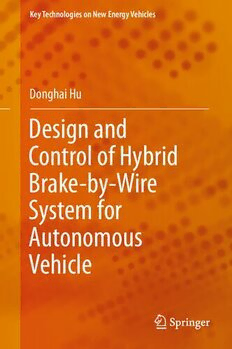Table Of ContentKey Technologies on New Energy Vehicles
Donghai Hu
Design and
Control of Hybrid
Brake-by-Wire
System for
Autonomous
Vehicle
Key Technologies on New Energy Vehicles
KeyTechnologiesonNewEnergyVehiclespublishesthelatestdevelopmentsinnew
energyvehicles-quickly,informallyandwithhighquality.Theintentistocoverall
the main branches of new energy vehicles, both theoretical and applied, including
butnotlimited:
(cid:129)
ControlTechnologyofDrivingSystem
(cid:129)
HybridElectricVehicleCouplingTechnology
(cid:129)
CrossDisciplinarydesignoptimizationtechnology
(cid:129)
SingleandGroupBatteryTechnology
(cid:129)
EnergyManagementTechnology
(cid:129)
LightweightTechnology
(cid:129)
NewEnergyMaterialsandDevice
(cid:129)
InternetofThings(IoT)
(cid:129)
CloudComputing
(cid:129)
3DPrinting
(cid:129)
VirtualRealityTechnologies
Withinthescopesoftheseriesaremonographs,professionalbooksorgraduatetext-
books,editedvolumes,andreferenceworkspurposelydevotedtosupporteducation
inrelatedareasatthegraduateandpost-graduatelevels.
Tosubmitaproposalorrequestfurtherinformation,pleasecontact:
Dr.MengchuHuang,SeniorEditor,AppliedSciences
Email:[email protected]
Tel:+86-21-24225094
Moreinformationaboutthisseriesathttps://link.springer.com/bookseries/16377
Donghai Hu
Design and Control of Hybrid
Brake-by-Wire System
for Autonomous Vehicle
DonghaiHu
SchoolofAutomotiveandTraffic
Engineering
JiangsuUniversity
Zhenjiang,Jiangsu,China
ISSN2662-2920 ISSN2662-2939 (electronic)
KeyTechnologiesonNewEnergyVehicles
ISBN978-981-16-8945-1 ISBN978-981-16-8946-8 (eBook)
https://doi.org/10.1007/978-981-16-8946-8
©TheEditor(s)(ifapplicable)andTheAuthor(s),underexclusivelicensetoSpringerNature
SingaporePteLtd.2022
Thisworkissubjecttocopyright.AllrightsaresolelyandexclusivelylicensedbythePublisher,whether
thewholeorpartofthematerialisconcerned,specificallytherightsoftranslation,reprinting,reuse
ofillustrations,recitation,broadcasting,reproductiononmicrofilmsorinanyotherphysicalway,and
transmissionorinformationstorageandretrieval,electronicadaptation,computersoftware,orbysimilar
ordissimilarmethodologynowknownorhereafterdeveloped.
Theuseofgeneraldescriptivenames,registerednames,trademarks,servicemarks,etc.inthispublication
doesnotimply,evenintheabsenceofaspecificstatement,thatsuchnamesareexemptfromtherelevant
protectivelawsandregulationsandthereforefreeforgeneraluse.
Thepublisher,theauthorsandtheeditorsaresafetoassumethattheadviceandinformationinthisbook
arebelievedtobetrueandaccurateatthedateofpublication.Neitherthepublishernortheauthorsor
theeditorsgiveawarranty,expressedorimplied,withrespecttothematerialcontainedhereinorforany
errorsoromissionsthatmayhavebeenmade.Thepublisherremainsneutralwithregardtojurisdictional
claimsinpublishedmapsandinstitutionalaffiliations.
ThisSpringerimprintispublishedbytheregisteredcompanySpringerNatureSingaporePteLtd.
The registered company address is: 152 Beach Road, #21-01/04 Gateway East, Singapore 189721,
Singapore
Preface
The autonomous vehicle is a complex electromechanical integration system. With
the development trend of electric and intelligent vehicles, the braking system of
it will gradually develop to brake-by-wire in order to achieve a more precise and
controllable braking effect. At present, autonomous cars are equipped with hybrid
brake-by-wiresystems,suchasacompositebrakesystemformotorandfrictionand
anintegratedbrakesystemforelectromagneticandfriction.Asaresearcherinthe
fieldofautonomousvehicles,Ihavefrequentlyfeltthatweneedamonographthat
givesacomprehensiveanddetailedintroductiontothehybridbrake-by-wiresystem
forautonomousvehicles.
This book focuses on the hybrid brake-by-wire system for autonomous vehi-
clesandpresentsacomprehensiveintroductionandresearchonthebrakesystem’s
modeling, design, and control. This book is composed of six chapters. The first
chapter introduces the industry status of hybrid brake-by-wire system, the second
chapter introduces the research status of hybrid brake-by-wire system, the third
chapter models hybrid brake-by-wire system, and the fourth chapter designs the
hybrid brake-by-wire system based on the principles of safety and energy-saving,
Thefifthchapterputsforwardthebrakingforcedistributioncontrolmethodofhybrid
brake-by-wiresystem,andthesixthchapterintroducesthemodeswitchingcontrol
ofhybridbrake-by-wiresystem.
Thebookiswrittenforengineersofhybridbrake-by-wiresystemforautonomous
vehicle,teachersandstudentsmajoringinautomobileandautomation.Wehopethat
this selection of materials can provide readers with some guidance in the future
designandcontrolofhybriddrive-by-wiresystemsforautonomousvehicles.
ThisbookissponsoredbytheNationalkeyresearchanddevelopmentprogramof
China“Integratedtransportationandintelligenttransportation”(2018YFB1600303).
Zhenjiang,Jiangsu,China DonghaiHu
v
Contents
1 IndustryStatusofHybridBrake-By-WireSystem ................. 1
1.1 MotorBrake ............................................... 1
1.2 ElectromagneticBrake ...................................... 2
1.3 Electro-HydraulicBrake ..................................... 3
1.4 Electro-PneumaticBrake .................................... 5
1.5 CompositeBrakeSystemforMotorandFriction ................ 6
1.6 IntegratedBrakeSystemforElectromagneticandFriction ........ 8
References ..................................................... 9
2 ResearchStatusofHybridBrake-By-WireSystem ................ 11
2.1 BrakingForceDistributionControlofHybridBrake-By-Wire
System .................................................... 11
2.2 ModeSwitchingControlofHybridBrake-By-WireSystem ....... 14
2.2.1 Mode Switching Control Under Non-emergency
Braking ............................................. 14
2.2.2 ModeSwitchingControlUnderEmergencyBraking ...... 16
References ..................................................... 18
3 ModelingofHybridBrake-By-WireSystem ...................... 21
3.1 MotorBrakeModel ......................................... 21
3.1.1 DrivingMotorModel ................................. 21
3.1.2 EnergyStorageModel ................................ 22
3.2 ElectromagneticBrakeModel ................................ 24
3.2.1 NonlinearAnalysisofSoftMagneticMaterials ........... 24
3.2.2 CalculationofElectromagneticBrakingTorque .......... 26
3.3 Electro-HydraulicBrakeModel .............................. 27
3.3.1 AirbagAccumulator .................................. 27
3.3.2 MotorPump ......................................... 28
3.3.3 BrakeMasterCylinder ................................ 29
3.3.4 Low-SpeedSolenoidValve ............................ 30
3.3.5 High-SpeedSolenoidValve ............................ 31
3.3.6 BrakeLine .......................................... 32
vii
viii Contents
3.3.7 BrakeWheelCylinder ................................ 33
3.4 Electro-PneumaticBrakeModel .............................. 34
3.4.1 SeriesDouble—ChamberBrakeValve .................. 34
3.4.2 RelayValve ......................................... 36
3.4.3 BrakeChamber ...................................... 37
3.4.4 DrumBrake ......................................... 38
3.5 VehicleBrakeDynamicModel ............................... 39
3.5.1 VehicleLongitudinalDynamicModel ................... 39
3.5.2 VehicleSingle-WheelBrakingModel ................... 40
3.6 HybridBrake-By-WireSystemModel ......................... 42
3.6.1 Model of Composite Brake System for Motor
andFriction ......................................... 42
3.6.2 ModelofIntegratedBrakeSystemforElectromagnetic
andFriction ......................................... 44
References ..................................................... 46
4 DesignofHybridBrake-By-WireSystem ......................... 47
4.1 Safety Design of Composite Brake System for Motor
andFriction ............................................... 47
4.1.1 SafetyDesignofPowerSupplyDevice .................. 47
4.1.2 SafetyDesignofSpareBrakeCircuits .................. 49
4.1.3 SafetyDesignofInlet/OutletValve ..................... 51
4.2 Energy-Saving Design of Integrated Brake System
forElectromagneticandFriction .............................. 52
4.2.1 EnergyConsumptionAnalysisofElectro-Hydraulic
Brake .............................................. 52
4.2.2 EnergyConsumptionAnalysisofElectromagnetic
Brake .............................................. 61
4.2.3 Energy-SavingDesignofIntegratedBrakeSystem
forElectromagneticandFriction ....................... 70
5 BrakingForceDistributionControlofHybridBrake-By-Wire
System ........................................................ 79
5.1 Braking Force DistributionControl ofComposite Brake
SystemforMotorandFriction ................................ 79
5.1.1 AnalysisofInfluencingFactorsonBrakingForce
DistributionControl .................................. 79
5.1.2 DesignandSimulationofBrakingForceDistribution
Control ............................................. 82
5.2 Braking Force Distribution Control of Integrated Brake
SystemforElectromagneticandFriction ....................... 86
5.2.1 Braking Force Distribution Control in Friction
BrakingMode ....................................... 86
5.2.2 BrakingForceDistributionControlinElectromagnetic
BrakingMode ....................................... 94
Contents ix
5.2.3 BrakingForceDistributionControlinCombined
BrakingMode ....................................... 100
References ..................................................... 103
6 ModeSwitchingControlofHybridBrake-By-WireSystem ......... 105
6.1 ModeSwitchingControlofHybridBrake-By-WireSystem
UnderNon-emergencyBraking ............................... 105
6.1.1 StabilityAnalysisofBrakingModeSwitchingProcess .... 105
6.1.2 ControllerDesignofBrakingModeSwitchingProcess .... 109
6.1.3 ModeSwitchingControlofCompositeBrakeSystem
forMotorandFriction ................................ 115
6.1.4 ModeSwitchingControlofIntegratedBrakeSystem
forElectromagneticandFriction ....................... 125
6.2 ModeSwitchingControlofHybridBrake-By-WireSystem
UnderEmergencyBraking ................................... 129
6.2.1 AntilockBrakingModeling ........................... 129
6.2.2 AntilockBrakingCoordinatedController ................ 132
6.2.3 AntilockBrakingHardware-In-The-Loop ............... 138
6.2.4 AntilockBrakingHardware-In-The-LoopSimulation ..... 144
References ..................................................... 149
Chapter 1
Industry Status of Hybrid
Brake-By-Wire System
The system integration of brake by wire and standard hydraulic brake or electro-
hydraulicbrakehasbecomeatrendindevelopingautomobilebrakesystemsinthe
future.Therearetwotypicalautomobileintegratedbrakesystems:compositebrake
systemformotorandfrictionandintegratedbrakesystemforelectromagneticand
friction.Thischapteralsodescribesthestructureandworkingprincipleoffourkinds
ofbrakes.
1.1 MotorBrake
AsshowninFig.1.1[1],regenerativemotorbrake(RB)includesdrivemotor,motor
controller, power battery, and battery management system. The drive motor has a
four-quadrant working capacity. The x-axis represents the direction of the motor
rotatingmagneticfield,andthey-axisrepresentsthedirectionofmotorloadtorque.
Whenthedrivingmotorworksatthefirstandthirdimagelimits,thedrivingpoweris
output,thefirstquadrantisforwarddriving,andthethirdquadrantisreversedriving:
Whenthedrivingmotorworksatthesecondandfourthquadrants,thebrakingpower
isoutput.Thesecondquadrantisforwardbraking,andthefourthquadrantisreverse
braking.
Whenthevehicleisbraked,thewheelwilldrivethedrivemotortorotatethrough
the transmission device, and the whole vehicle controller will send a regenerative
brakingcommandtothedrivemotor.Atthistime,thedrivemotorwillimplement
motor regenerative braking. On the one hand, the vehicle braking energy will be
recoveredandstoredinthepowerbattery,andontheotherhand,thebrakingtorque
will be applied to the wheel. As a non-contact braking mode, motor regenerative
brakingcansaveenergyconsumption,improvevehicledrivingrange,andhaveno
brakingdustandnoiseinthebrakingprocess.Itisanenvironment-friendlybraking
mode. However, the implementation of motor regenerative braking is affected by
©TheAuthor(s),underexclusivelicensetoSpringerNatureSingaporePteLtd.2022 1
D.Hu,DesignandControlofHybridBrake-by-WireSystemforAutonomousVehicle,
KeyTechnologiesonNewEnergyVehicles,
https://doi.org/10.1007/978-981-16-8946-8_1

